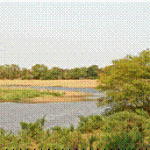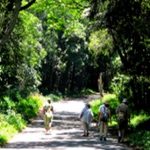TREE LIFE
December 2013
This is the 400th Tree Society Newsletter !
MASHONALAND CALENDAR
Tuesday, 3rd December: Botanic Gardens Walk with Tom Muller: Meet at 4.45pm in the car park of the Botanic Gardens.
Sunday 8th December: Christmas Social at Val d’Or, Ruwa: Our venue this year is Bill Clarke’s property, Val d’Or; thanks go to Bill for agreeing to host us.
We will serve tea from 9.30 am. After that, we will have a botanical walk and that will be followed by our ever-popular general knowledge quiz, which has again been compiled by Adele Hamilton-Ritchie.
Please bring some Christmas fare to share for tea, and bring your own lunch, a wine glass and a chair. The Society will provide some wine for those attending.
CHANGE IN TREE SOCIETY CABS ACCOUNT
Just to confuse everyone, the Tree Society CABS account number has been changed from 9015224328 to 1002549477.
So, our bank account is:
Bank: CABS
Account Name: W.R.Clarke Tree Society
Account Number: 1002549477
– Ed
TREE OF THE MONTH
Baikiaea plurijuga
Family: Leguminosae/ Fabaceae
Subfamily: Caesalpiniodeae. Common names: Zambezi teak, Nd: Umkusu/ Umkuswi.
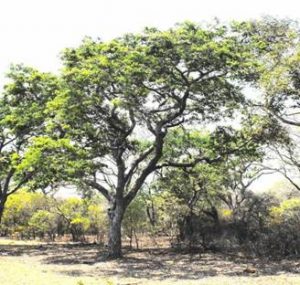
Baikiaea plurijuga
As a matter of interest the name “Zambezi Teak” is a misnomer, given because of the dark, hard, heavy wood. The real teak (Tectona grandis) is in the Lamiaceae family (like our Vitex payos, Clerodendrum and Lippia javanica for example). The original teak comes from the Far-East, the only real Burmese Teak we ever saw was at Aberfoyle in the Honde Valley during a Tree Society visit in September 2010.
Baikiaea plurijuga appears to grow only on the deep Kalahari Sands. It can reach 15 m of height in good conditions, but is often smaller. The canopy is domed and broad. Travelling from Bulawayo to Hwange, the light bark makes the trees conspicuous (with age the bark becomes darker and fissured – same as people) and as you pass the airport of Vic-Falls the road is lined with teak. From December to March, when in flower, the masses of purple flowers are most attractive.
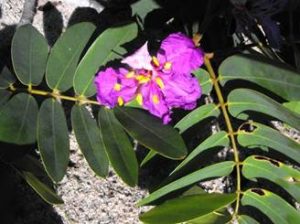
Baikiaea plurijuga flowers and leaves
The leaf is compound and paripinnate with four or five pairs of opposite leaflets. When young they are covered in velvety brown hair.
The flowers are conspicuous, mauve with contrasting yellow stamens. They are borne on axillary racemes some 30 cm long.
The fruit is a flat, brown woody pod with an interesting little hook on the apex. It is explosively dehiscent, a characteristic that assists with the dispersion of the seeds to a certain distance from the mother tree.
The genus name is in honour of Dr. William Balfour Baikie, a West African traveller and Royal Navy surgeon on the Niger Expedition of 1854 to 1857. The specific epithet is indicative of the many paired leaflets in the pinnate leaf.
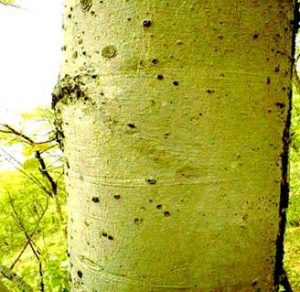
Baikiaea plurijuga bark
Baikiaea plurijuga has a durable and most versatile wood. In this country it was used extensively to make railway sleepers, now the teak sleepers have been replaced by concrete ones, but the old ones have proved to be a gold mine for some enterprising furniture makers. Other uses of new timber include furniture, cabinetry, flooring, turning and carving. The tools must nevertheless be suitable as the wood is very hard and will rapidly blunt normal woodworking tools. The timber has also been used as a mining timber but is now being replaced by steel.
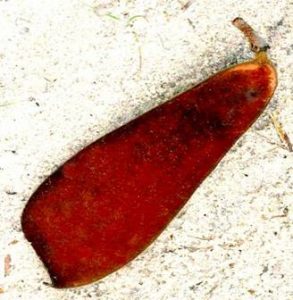
Baikiaea plurijuga pod
Sources:
Coates Palgrave, K. 1976. Trees of Southern Africa. Struik, Cape Town.
Flynn, J. n.d. Baikiaea plurijuga – Rhodesian Teak. World of Wood.
www.woodcollectors.org/pdf/wds031.pdf
– J-P Felu
TREE SOCIETY VISIT TO SELDOM SEEN in the VUMBA 15 – 18 November
Day One – Friday 15th November
This was the first official Tree Society visit to the Vumba since the memorable trip in August 2003, during which Werner Fibeck broke his leg.
From a more personal point of view, this was my first visit to the upper parts of the Vumba since 2007 and to Seldomseen since 2006 when Bart Wursten and I recorded plants there. Seldomseen is also rather a special place because we were friends with the former owners, Alec and Cecilia Manson and we spent all our Christmases there from about 1984 to c. 1996. Most of our Christmas mornings while our kids were small were spent at Seldomseen and I have fond memories of children opening presents at an early hour on Christmas morning.
As is normal with first days, this day was largely spent on the road. Meg Coates Palgrave, Tom Muller and I travelled together to the Vumba under cloudless skies; yet another hot day. The journey from Harare to Mutare was straightforward, although there were some delays caused by road works. The longest of these was on Christmas Pass where a very long stretch of road was under repair and we had to wait about 20 minutes, surrounded by vendors doing a brisk trade in water, newspapers, hard-boiled eggs and queleas.
We reached Seldomseen at c. 2 pm and checked in. We stayed in the upper cottage (Witchwood), which was to be the centre of operations for gathering together in the evenings and for meals.
After a late lunch we were joined by Peter Buttress and Judy Wilson, the former a long-standing member of the Society who lives in the Vumba and the latter a visitor from Mutare. We then walked down the hill, examining the species in the forest and at the forest edge. The forest itself is largely regenerating forest consisting of Macaranga mellifera (the Mountain macaranga) and Polyscias fulva (the Parasol tree). Tom led this walk and expressed himself in strong terms about its non-pristine nature and the lack of interest.
Although Tom’s observations are I admit quite correct; there were indeed numerous invasive and planted species to be found and the forests in which we were walking were largely secondary; I am not quite such a purist myself and I actually thought that there were a number of species of interest.
One such was a large liane from the nettle family, Urticaceae, which climbs to considerable heights in the forest and bears adventitious roots along its stems. This was Urera hypselodendron, which I had always thought was non-stinging. I was therefore rather surprised to be stung twice while handling a piece of it. Later we checked the description and found that it does refer to occasional stinging hairs.
Oxyanthus speciosus (the Whipstick tree) is a member of the Coffee family. It has large dark green, opposite leaves and bears cluster of white flowers in the leaf axils. These were sadly not quite out in mid-November.
Ochna holstii (the Common forest ochna) was seen frequently in the understorey. Like all Ochnas the upper midrib is raised prominently above the leaf surface but in addition it as a strongly wavy leaf margin and leaves borne in a plane. At the time of our visit they were young and had a characteristically brownish look.
Frequent here was Aphloia theiformis, the Albino berry with its clusters of white berries as also was Peddiea africana, the Green flower tree. The leaves of this species are frequently attacked (by some sort of insect) and they then appear strongly white spotted. Later we came across an umbel of the green flowers which give this tree its common name.
Meg pointed out the unusual stem and leaf structure of Piper capense in which the stipules are fused to the leaf petiole.
Peter Buttress asked me about three non-tree species. A grass by the side of the track was an introduction: namely Bromus catharticus. The Amaranthaceae with the prickly inflorescences was Cyathula cylindrica and the climbing species with small greenish-yellow leaves was Osyridicarpos schimperianus. The latter is largely an eastern districts species of forest edges and high rainfall areas, but it does occur near Harare. We have found it twice in the Umwinsi River area.
Further on we came across a wild Cucurbitaceae (cucumber family) with large yellow flowers and thickly-textured dark green leaves; this was Peponium chirindense. Nearby and climbing high into the forest trees at the edge was a yellow-flowered exotic Bignoniaceae climber. Known as Amphiliophium crucigerum it was formerly called and is still well-known as Pithecoctenium crucigerum. This species does appear to be slowly becoming more invasive.
Also in the forest edge, we came across the spiny branches of Canthium inerme (the Turkey berry).
The evening saw a convivial gathering of all 10 participants around the table at Witchwood: Bilal Khatri, Eva Keller, Graham Mills, Isla Grundy, Marilyn Dickinson, Mark Hyde, Mary Lovemore, Meg Coates Palgrave, Tom Muller and Vernon Dickinson.
For the record, there was no Econet coverage at Seldomseen (there is NetOne) and all I got was a weak Mozambican signal (Mcell). There was also power on arrival but it came on at c. 6 pm and was on all evening, which was nice for recharging things.
– Mark Hyde
TO BE CONTINUED………………
SOME TREES OF RWANDA
Our recent trip to the Gorillas and Chimps of Rwanda took us to magnificent forests where I was able to identify some of the trees with help from the guides. This list is obviously superficial and some names given to me may be incorrect. Nevertheless there are a few trees in common with the Eastern Districts and some species whose families are represented here, so there are similarities and large differences.
Rwanda is an extraordinary country (no litter, everything works) which is heavily over populated, with a population of 12 million people or 420 people per square kilometre, so every inch of the steep hillsides is occupied where virtually no indigenous trees survive. Nevertheless there are still remnants in reserves of their magnificent forests. The violent volcanic origin of the region which lies on the Albertine Rift, has given rise to steep hills and valleys with rich volcanic soils and a high rainfall rich in plant and bird species, many of which are endemic. The western boundary is Lake Kivu which flows south into Lake Tanganyika, having reversed its flow with the uplifting of the Virunga Mountains, causing the formation of Lake Victoria. To the north of the Virungas drainage is to Lakes Edward and Albert and the Albert Nile. Interesting to have been to the watershed of the mighty Congo and Nile Rivers.
We had a seven hour drive south west through heavily populated country, with interminable ascents and descents of the thousands of hills until we reached the magnificent Nyungwe Forest on the edge of which are big tea estates. The lodge looked over forested mountains. Nyungwe covers 970 square kilometres but is unfortunately in two areas, divided by an area invaded by refugees, but the park is now protected. Nyungwe has 200 tree species and 280 bird species many of which are endemic, as well as chimpanzees and monkeys.
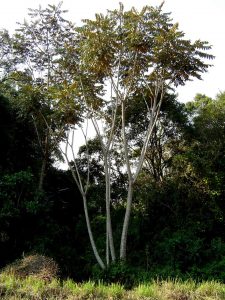
Polyscias fulva; Bart Wursten; Vumba; https://www.zimbabweflora.co.zw
The trees that stood out as being in common with the Eastern Districts were Newtonia buchananii, large buttressed specimens of which grew on ridges, large Polyscias fulva, Myrianthus holstii which they call Celebral fruit as the fruit resembles the brain and Dracaena steudneri, together with another Dracaena afromontana. The Tabernaemontana looked like our soccer ball fruit, but I couldn’t verify that. Entandrophragma excelsum, a mahogany, does not occur in Zimbabwe (our species is E. caudatum). Trees which were unfamiliar were Trilema sp whose fruit are eaten by chimps, Zanthoxylum gilletii the “unclimbable tree” because of the large spikes on the stem, Symphonia globulifera which has bright red flowers, Musanga leo-errerae which has palmate leaves and whose fruits are eaten by chimps.
Next day we visited the Uwinka part of the Nyungwe, which has an excellent visitor centre with magnificent views over the forested valleys and mountains full of noises of chimps hunting colobus monkeys and turacos of which the Ruwenzori turaco is endemic. We started down a very steep path towards a deep ravine through thick forest for the canopy walk. I’ve done canopy walks before which are usually through or over the canopy. Well this one was in three parts spanning a deep valley 80 metres below! Pretty scary as it bounced and swung, so we saw little of the forest.
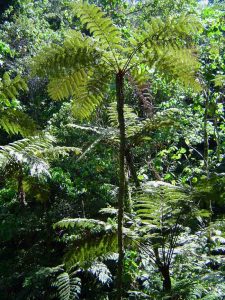
Cyathea manniana, spiny tree fern; Bart Wursten, Vumba; https://www.zimbabweflora.co.zw/
Besides the trees seen the day before, some more familiar trees were seen, Cyathea manniana, the spiny tree fern, a very large Faurea saligna and a small Podocarpus latifolius. Prominent in the forest is Syzyigium guineense subsp. Afromontanum, the Forest waterberry, which is common here.
Unfamiliar trees were Lobelia giberroa the giant lobelia with a striking three meter inflorescence and Hagenia abyssinica which I recognised as a straggly tree which for some strange reason our Forest Research Station asked me to try at our Mountain Home! There is also Parinari excelsa related to our Mobola plum as well as Ocotea usambarensis in the same family as stinkwood. A striking tree because of its bright red large new leaves was Carapa grandiflora. There is also a Macaranga sp and Erica johnsonii. On the forest floor was a delightful endemic Impatiens kagami named after the President.
We travelled next to Lake Kivu with little of interest except that it contains a huge reservoir of methane gas and carbon dioxide (which could explode if a large larva flow enters the lake), spending the night at Gisenye which is separated by a wall from the infamous Goma now the scene of fighting in the DRC. Our next stop was the Volcans National Park on the southern slopes of the Virunga mountains which go up to Karisimbi at 4500 metres with Uganda to the north and the DRC and the active Nyiragongo to the west. National Parks are contiguous in all three countries and has 900 Mountain Gorillas. We got very close to gorillas but that’s another story.
Compared to the Nyungwe, the trees in the Virungas were rather disappointing. We climbed up to about 3000 metres. The lower slopes are dominated by large patches of the bamboo Arundinaria alpina with very few trees and these tended to be Neoboutonia sp which looked identical to our N. macrocalyx with large ovate leaves. In between the bamboo patches are a thickets of herbaceous plants including a nasty stinging nettle with huge spines (no wonder you should wear gloves). When we met the family of gorillas they were feeding on bamboo and herbaceous plants including a thistle which they strip through their teeth to get water, because we saw no streams despite the boggy ground and high rainfall. Higher up was
Hagenia abyssinica and a Hypericum sp growing as a tree, looking identical to the Eastern Districts one. There is also a tall Senecio erici–rosenii with yellow flowers. We did not get above the tree line at 3500 metres, above which occurs Lobelia wollastonii and L. lanuriensis.
A memorable trip, we ticked off chimps, gorillas and magnificent forests but missed forest elephants and buffalo. Just as well.
– John Meikle


